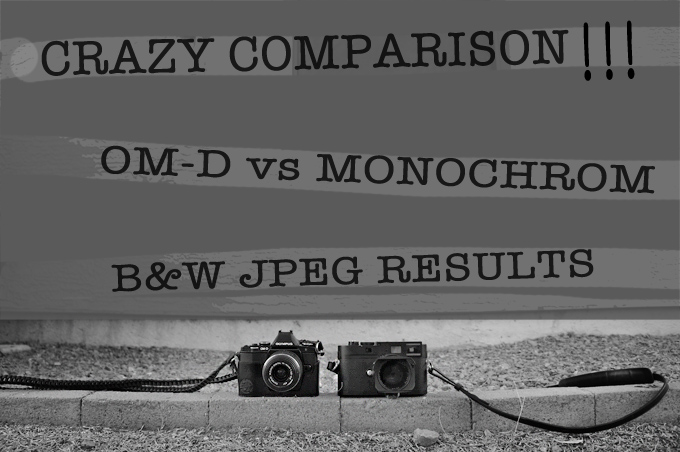
The Crazy Comparison Returns! The $999 Olympus OM-D vs the $7995 Leica Monochrom!
TONALITY TESTS – This is not a comparison of sharpness, detail, or anything else but B&W tones.
So as I was going through all of my recent e-mails I found more than 10 asking me for a comparison between the Olympus OM-D and Leica Monochrom. Some even asked me to shoot the OM-D in Monochrom mode with the Orange filter applied and to shoot my Monochrom with a real Orange filter applied. So I did just that.
Before anyone freaks out let me say that this is called “Crazy Comparison” for a reason. I am pitting an $8000 camera body against a $1000 camera body and using the KIT ZOOM on the $999 camera and a $5000 35 Lux FLE on the $8000 body. So in reality, this is a $1100 combo vs a $13,000 combo.
Also, almost all of these are just snaps in my horribly barren backyard. NOTHING scientific goes on in my Crazy Comparisons. I just shoot both images using the same ISO and aperture and equivalent focal length and compare. Anyone who has seen one of these before knows they are done mainly for fun, but sometimes they can be eye-opening.
[ad#Adsense Blog Sq Embed Image]
WHAT YOU SHOULD KNOW BEFORE LOOKING AT THE IMAGES BELOW
These have all been shot as JPEG to compare out of camera JPEG B&W files. The Olympus has a feature where you can set it to “Monochrome” and apply colored filters in the menu. I chose to use “Orange” because this is my fave filter on the Leica Monochrom. You can not shoot RAW with the Olympus and have these settings applied so these are straight out of camera JPEGS only! There is absolutely NO DOUBT that the Leica would trounce the Olympus here for detail and ability to print huge, but what I wanted to see was if the Olympus, using its own Monochrome mode and filter could match the Leica in tonality and character. Even using a dinky kit zoom!
So before the complaints start keep in mind this is a just for fun comparison as I have ALWAYS done for years now just to see out of camera JPEG results in Monochrome from each camera. One specially made boutique hot rod and one jack of all trades that the masses in the digital photo community can more realistically afford.
Take a look at the images below and click on them for larger views. Can you tell which camera took what image? One of them will be especially easy (set#2). I can see the differences but it could be only because I know what image came from what camera. Can you? The answers will be at the very bottom of this page as to what image took what.
If you guys MUST see full size images because you are interested in sharpness and detail then be patient. In 2-3 days I will update this page with a couple of full size files from each. I am taking a little photo trip this weekend so I can get some real images 🙂
SET#1 – One of these is from the Leica, one from the Olympus. Click to look closer and see what you think. Images have been resized to 1500 pixels wide. ALL are OOC JPEGS with no tweaks at all. BOTH are using Orange Filters. The Leica with an actual filter and the Olympus with in camera processing.
–
SET#2 – This one is easy so I will give it away. The Leica can not focus as close as the Olympus. Same 35mm focal length equivalent with the Oly but I was closer in.
–
SET#3 – Which is Which?
–
SET #4 – The tones look similar to me in this one. Can you spot the Leica?
–
SET#5
–
SET #6 – These were shot at ISO 1250 and 50mm (50 equiv. on OM-D) and f/4
ANSWERS:
SET#1 – Top Leica MM – Bottom OM-D
SET#2 – Top OM-D – Bottom Leica MM
SET#3 – Top Leica MM – Bottom OM-D
SET#4 – Top OM-D – Bottom Leica MM
SET#5 – Top OM-D – Bottom Leica MM
SET#6 – Top Leica MM – Bottom OM-D
UPDATED by request: Shadow Recovery Quick Test – Click each of the recovered images for FULL SIZE files. BOTH were from RAW this time.
–
NOW both files with the shadow area recovered. BOTH were 35mm Equivalent, BOTH were at f/4, BOTH were at ISO 320 – Shutter speed of Leica was 3000, OM-D 3200
CLICK THESE FOR FULL SIZE FILES – THESE ARE FROM RAW
1st one is the Leica – 35 Lux, f/4, ISO 320, 1/3000s
–
Now the OM-D with Kit Zoom – 35mm equiv, f/4. ISO 320, 1/3200s – This is where you see the weakness of the kit lens with softer edges

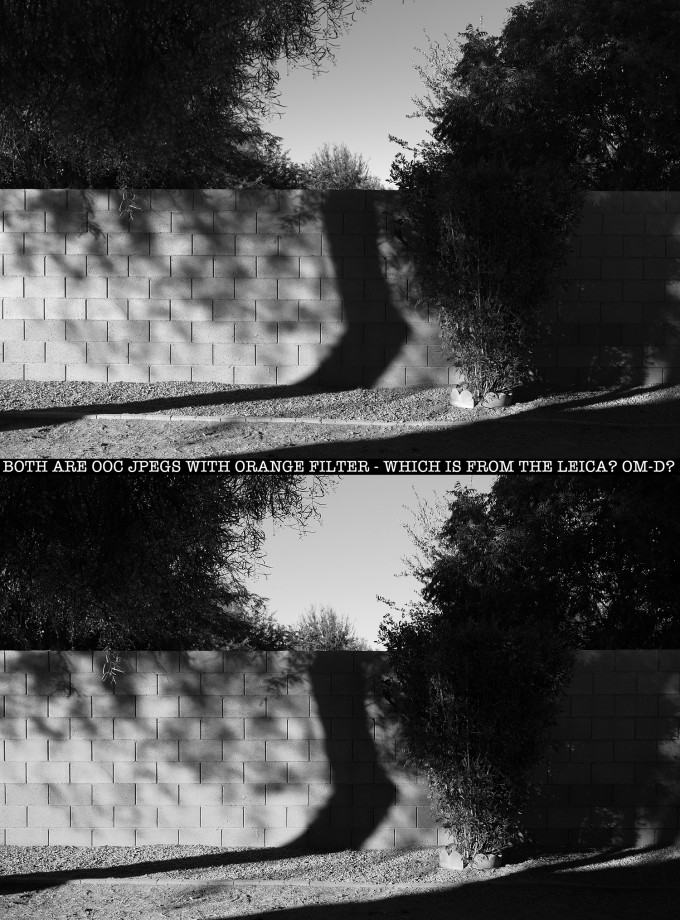
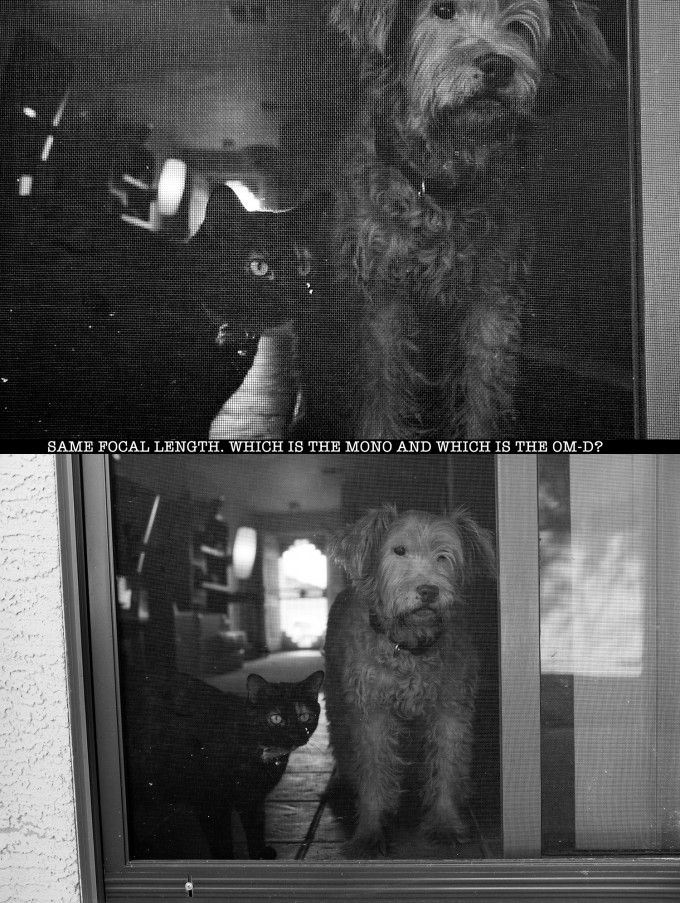
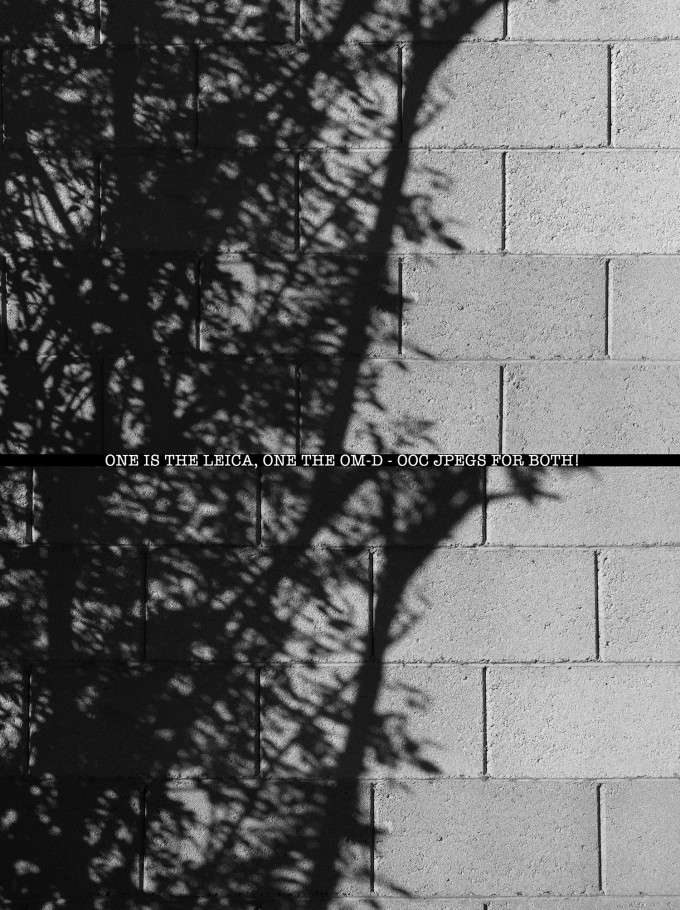
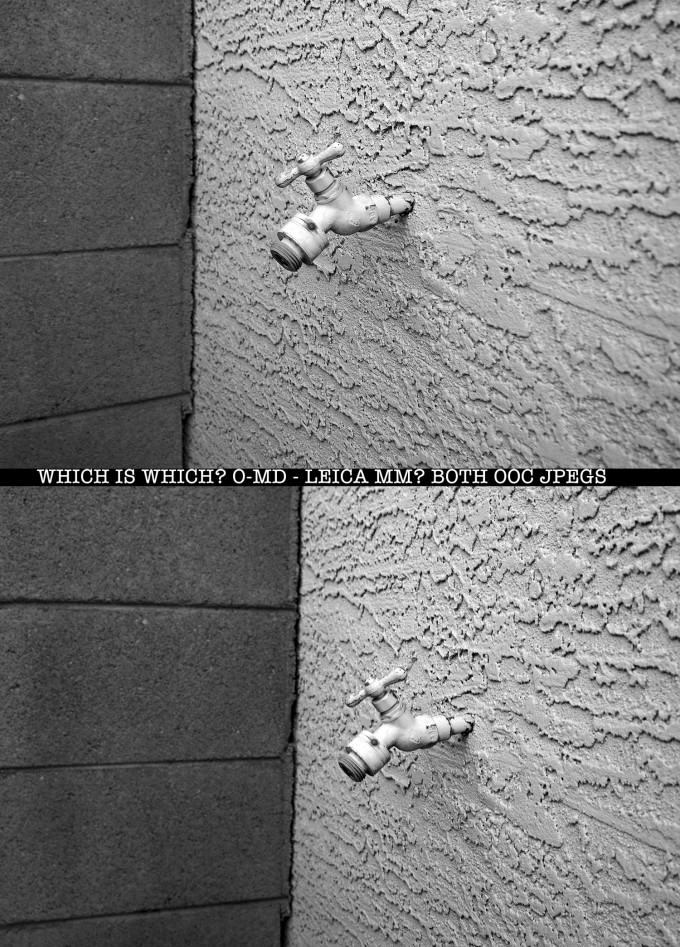
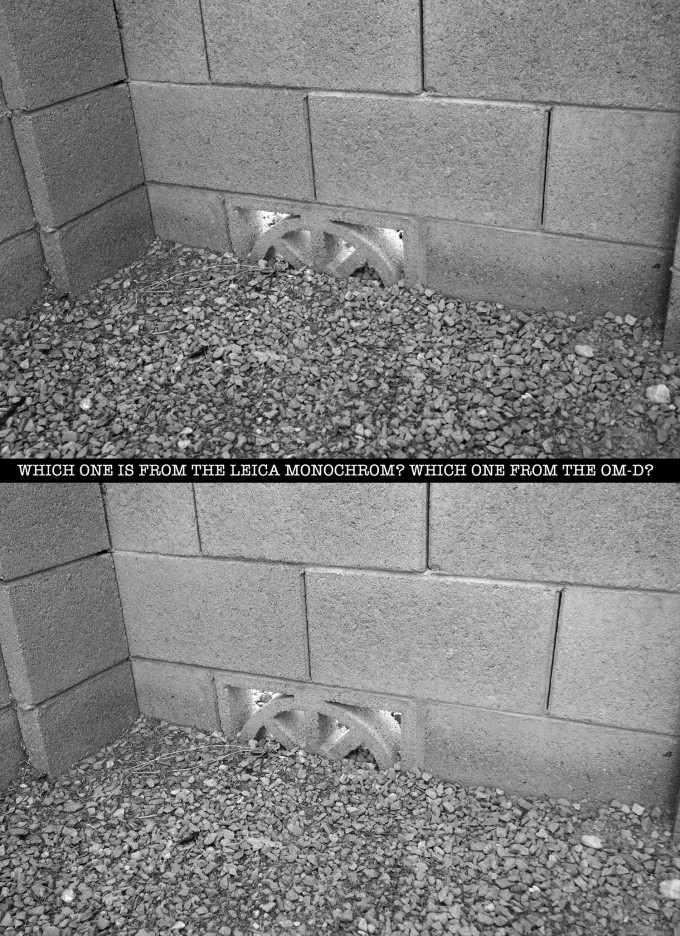
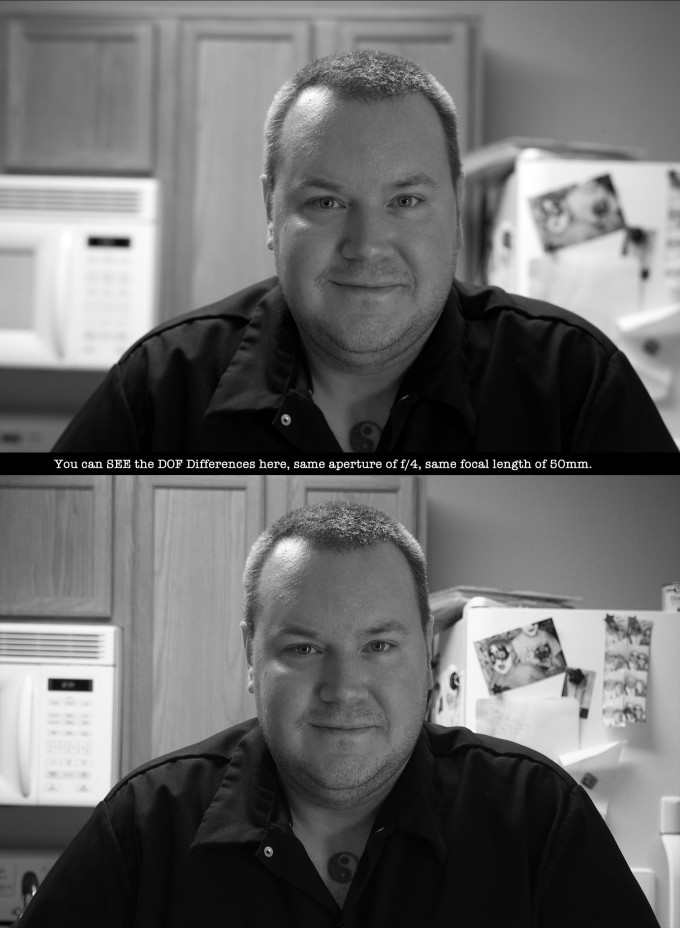
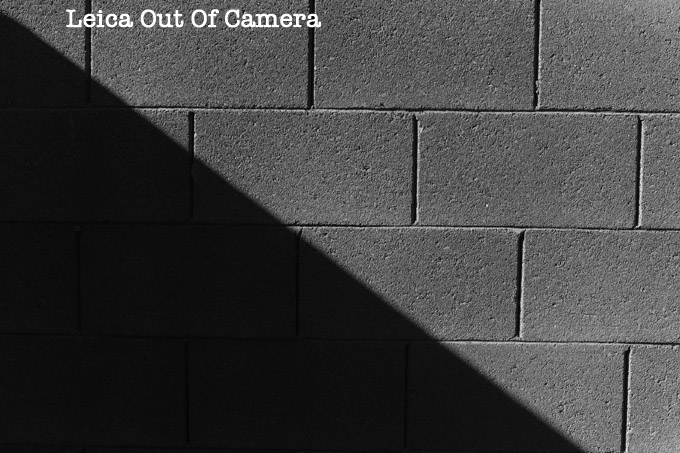
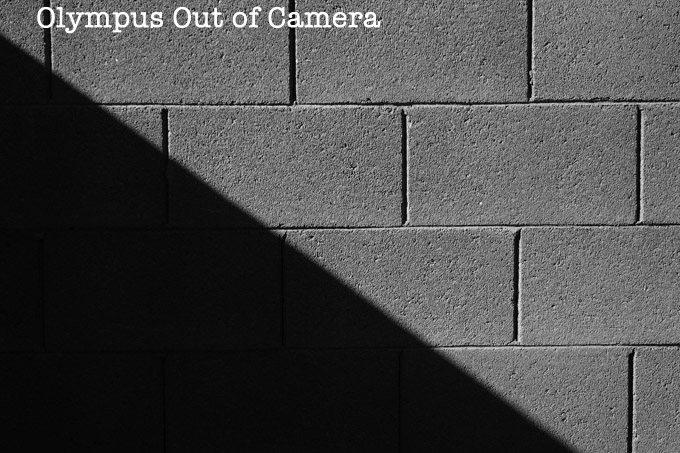
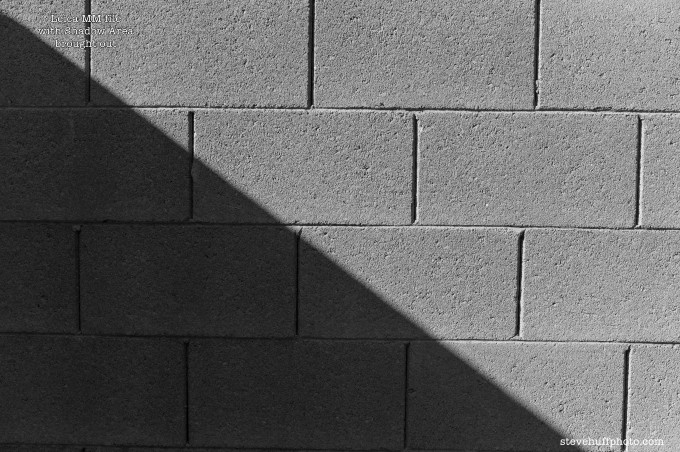
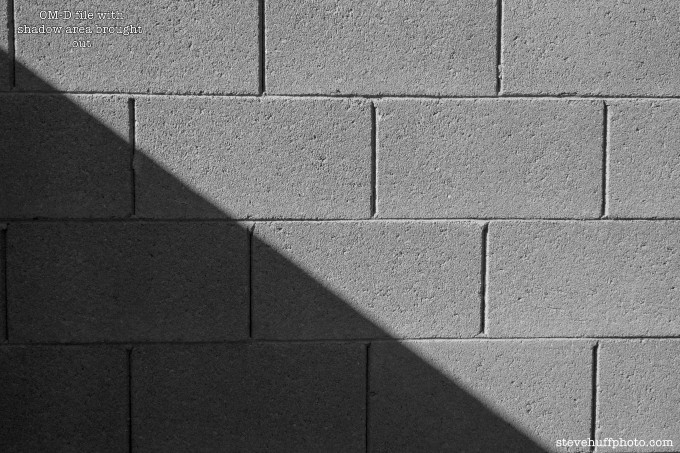
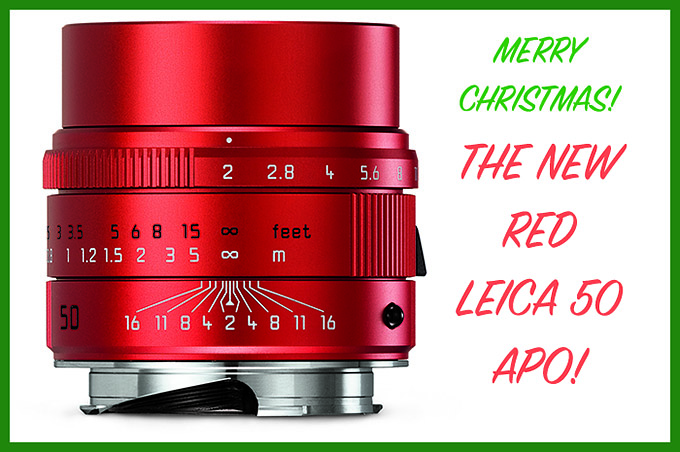

Leica wins all the way… and not because of the images here, but because of the images I shoot with it. After putting ONLY my curve on them in Photoshop, the true ability of my Leica lenses becomes so apparent, as they blow ANY other lenses I own out of the water. Canon 24mm 1.4, Pentax 67 90mm, etc… etc… Color, sharpness, and contrast is UNMATCHED with Leica lenses, and I don’t see that changing any time soon.
Interestingly, I just posted a question about out-of-camera B&W jpegs on DPReview in the Micro43 forum. I’m looking to decide between the Olympus (EM5/EM1), Fuji (XE2/XT1) and the GX7. I thought maybe B&W might be a defining system difference, but it doesn’t seem to be.
Almost everybody in the forum was telling me to “forgot it” and do post production. I’m an amateur, want-to-be hobbyist and enthusiast. First, I want to learn the art and science of the camera, the shot, the light and the scene. I should be able to get high quality out-of-camera shots with $2,000 worth of camera and lens – I hope. Post production is something as a learning tool later on, and I see its merits, to a point.
Then, somebody in the forum actually read my question, understood it and sent me the link to this page.
I can tell the difference in two of the sets. The first set is very noticeable in the sky and trees. And, the last set with the brick wall shadow test is noticeable. Now, I guess that a better lens on the OMD may improve its output.
Also, I guess seeing the prints might make a difference too.
But, we’re talking a $10,000 (subtle) difference and how many people are in that stratosphere of spending? How many casual and professional photographers would look at the OMD shots and say that they’re terrible?
Glad I found this website. Lots of other good stuff on it.
Thanks
Andrew
To be honest I correctly picked the Leica in every set of pictures. It was very easy. The Olympus cannot resolve highlights as well as the Leica. I noticed this limitation on the Olympus rather early when reading reviews.
An excellent example of this limitation is available at dPreview. They provide a comparison page for Image Quality comparison in their E-M1 Preview. You can compare the E-M1against a list of other cameras including the OMD. It is pretty obvious on this page that Fuji, for example, resolves highlights much better. In fact it appears the the OMD even resolves highlights slightly better than the EM1!!!
The difference in resolving highlights does not make me like the OMD any less. But Olympus needs to work on resolving highlights. It is an issue that cannot be sidestepped.
Steve, I am confused as to what this comparison was meant to achieve as it certainly promoted a lot passionate debate. Prima facie it would appear the less expensive OMD holds up well when compared to the Leica.
To my mind if you could afford the Leica and wanted the Leica you would not be disappointed with it. However, if the Leica was beyond your financial resources/capacity there are a myriad of other cameras, like the OMD, and associated equipment like lens that would produce excellent and satisfying results too.
To my mind we have a great deal of choice in high quality equipment now that will cater for all budgets/experience. That has to be a good thing for those with a passion/interest in photography, those who make a living from it or both.
I do have an OMD and two of the primes (45mm f1.8 and 17mm f1.8). Being just a mere hobbyist, I did not want to spend too much and the OMD was the best fit for me amongst all the other excellent mirrorless choices that were out there eg Fuji, Sony, Panasonic, Nikon and Canon.
Thank you for spending the time to answer my questions. By the way, I was able to pick out a few that I thought were the Leica, two based on slightly more range of tones from light to black, and one because of a difference in depth of field. But other than the depth of field difference, the differences were subtle, again to my eye. Maybe to others, and especially those who work in B&W, as you say, those differences are very meaningful. Again, thanks Giorgio.
It’s like that John, to others and especially those who work in B&W, those differences are very meningful. If those differences are strongh enough and if they have enough money to spend, then they should better give Leica Monochrome a try. I think that’s the message that Steve tried to give us. But remember also that eyes are very strange, sometimes they are not able to see, some other time they only see what they like or prefer to see… and sometimes it’s only the monitor that is not able to show. But, as your name is “Afflitto” try not to be so sad, to be not only just curious. “Don’t worry, be happy”. You have a wonderful little camera, enjoy it and… “Try… just a little bit harder”
Cheers!
Steve Huff did a useful crazy comparison. You may realise that Olympus B/W and Leica B/W are almost identical, another happy guy may think they are quite different. Yes a fun comparison, but no one has to spend his life reading comparison written by another. Comparisons are almost everytime crazy, lot of people tries to compare apples and bananas, wishing to find out what’s the best! But you can’t really understand what Steve wrote and showed us, without trying a lot by your own. So, if you are really curious you can try to squeeze till the last drop all the possible quality out of your Olympus Epl and your printer. Then you have to do a useful comparison between what you see in your monitor and what you can print on a sheet of paper. It will help you to understand better what Steve wrote. And if you are still not satisfied with the quality of your prints and begin to notice some quality differences between your prints and the prints that a professional lab is able to give you out from the same photos, then you have to try with multiple black inks. ( I hope that Steve will kindly allow me another link: http://www.northlight-images.co.uk/stuff2/?p=1532). Fine… you now arrived at the end point? Oh no, you’re just at the beginning! Just a little example… Once I tried Tri-X with Rodinal… Same photograms from the same film, cutting some photograms and developing them different. Same developer, Rodinal, but different temperature, agitation, diluition…the results seemed quite different… then I took up one of that photograms and begun to print it with different papers and paper developers. Again the results were quite different. So if you are really very curious, with no more than 150/200$ you can buy a very fine used traditional analog camera, an enlarger, and a lot of indispensable other little things, and begin to try and realise the differences. Since Kodak closed his doors some times ago (and they used to say: you have only to click on the shutter, we will do the rest) , we are all almost back to the middle age with BW analog photography, everyone has to try by himself… So I suggest you to evolve from “just curious” to enthusiast, there’s much more fun!… and if you arrive at the death end point, only then you will exactly realise that you have spend a lot of time, a half of your life, comparing apples and bananas…but now you exactly realise every little difference and you can tell your friends you had lot of fun.
Cheers!!!
I don’t understand. Steve claims that all images were shot with equal settings, so the Leica image should always have the smallest DOF. But in sets 1 and 4, the DOF of the Leica is larger.
Anyway, the most important difference (IMO) is the sharpening. The OM-D shots have more sharpening halos, which made me prefer the Leica shots. But that is a matter of post-processing. At 1500-pixel wide images, we’re not looking at in-camera sharpening anymore.
I’m just curious. Now please don’t jump on me because I know little about black and white photography. I have a digital camera (Olympus EPL2) but have actually never made a print from it (yet) in either color or black and white. How does digital black and white compare with film black and white in terms of tonal range and other qualities?
Sorry John,
no one surery will jump on you because you know little about black and white photography, but it’s really impossible to teach you even just a little bit in so a little space. Just a very little exemple.. you ask about B/W in terms of tonal range… so if Steve Huffs, as I hope, will agree, I give you a link that leads to something interesting about Dynamic range…
http://www.dantestella.com/technical/dynamic.html
yes, only DR! And it’s not so easy to understand…and the other qualities?… You ask to compare digital and film BW… but on a monitor… on a print.. digital prints versus chemical paper… enlarger or printer, and if only on printer .. what kind of printer, what kind of paper and inks…? But you tell us you are “just curious”… and you say you have a Olympus epl2, a very fine camera… so perhaps you have also a priner, you have only perhaps to buy some ink, some fine quality paper… then you can just try to print colour or B/W, why not?
Well, I guess if I wanted to compare I would say a B&W digital print from a digital camera vs. a B&W print from paper and chemicals because I imagine B&W film enthusiasts develop and print their own film. And why would Lieca make a camera for only B&W. I guess making a B&W digital camera/sensor that can give the best black and white images precludes from also making the camera shoot color images. Still, those B&W photos comparing the Leica monochrome and OM-D don’t seem all that different, at least to me, to warrant investing in a camera that shoots only B&W, unless that is all you ever shoot.. By the way, thanks for the link. I’m not a novice to photography but most of my experience is color film. I don’t have film cameras any longer but even when I did the number of times I shot a role of B&W film can be counted on one hand. I have, however, sometimes admired B&W photos.
First of all, sorry for my horrible english, I’m italian. I was a professional landscape and architecture photographer some years ago. Shoot with Mamiya Rb, 645super, Linhof Master Technika and some 24x36mm cameras. At that age DR depended “almost” only on films and film format ( 4×5 inch., 120, 35mm)Tri-x,or FP4, or PanF… and the DR was the same on a Nikon or Pentax, or Zenith. I wrote “almost”…4X5inch, 120 film cameras “seemed” to have a different DR. ( and also HAD different sharpness). Not much has changed on the digital Era, it’s just math. So it’s really a Crazy Comparison. Leica Monocrome photos are easy to detect and clearly better. DOF depends on circle of confusion, You cannot compare a 50mm Summicron with Olympus 12-50mm at 50mm focal lenght, they have different circle of confusion so the DOF is different. Today I have a lot of fun with my Olympus omd em5. The 12-50mm is a nice lens, I agree with you Steve, not a super lens but it’s not possible to have all, and all in a cheap lens! So I tested with adapters some legacy 50mm lenses, Pentax SMC 1,4 (wow I like it), Nikon f.2, Olympus f.1,8 (like it to), Industar 6IL/Z f. 2,8 ( not bad at all). Had very nice with all of them and a better DOF control, the “look” of photos seems a kind
“vintage”, like it a lot!!! I wrote about a better DOF control… not about a precise DOF control. Again it depends on circle of confusion. Using a legacy lens on a micro 4/3 you lose the distance scale and DOF scale, they will tell you no more the truth. Anyway you can shoot wide open, and it’s fantastic.
So back to the Crazy Comparison… Leica monocrome is better… how much better? That’s not the really problem… the problem is: how much money you wish or are disponsable to spend to have a “some” better lens or camera?…. And Leica cameras are (perhaps) not allways the best but simply, since everytime, DIFFERENT cameras, like it or not. So I like and enjoy my Olympus omd em5… but….
Nice little test, I got most right by looking at the shadow detail, then find Steve gives it away by showing the recovery possibility.
Nice, But as others have commented what about large samples. Well. I have spent days (All day, Retired) studying flicr images using m and L39 lenses. ( I need a 28mm, but not limited to, for the E-M5) After having multiple tabs in multiple browser windows open I can tell you that the M8.2 seems to give better images than the M9, which was very disappointing (including bad bad noise). Lens sharpness had little to do with good pictures, exposure and composition were most important over and above lens brand and camera brand. Do it look at the pictures that say “look at me” you will be surprised..
The real test is how much money Leica users are ready to pay for The range Finder experience. 10m 15m ??? It real y make no sense to me. and i love Leicas tu this is way to much for a camera You will change every 5 to 10 years.
Greg
Much more interesting and less crazy would be to put the Panasonic Leica Summilux 25 on the OM-D and a Leica 50 Summilux on the Monochrome… Then i really wonder how much difference one can se…. Do that please
…now that would upset the apple cart.
I love it when Steve does this kind of stuff!
It just goes to show that, sure, the resolution of the MM is ultimately a bit better than the OMD (and I’m sure the OMD out ranks the MM in other areas) but, as far as photography goes, both cameras are capable of taking excellent photos and the artistry lies in the hands of the photographer.
Sometimes I think that Alfred Stieglitz’s photos of Georgia O’Keefe’s hands are the most beautiful photos I’ve ever seen and way back in the 1920’s, he shot with a Graphlex camera; primtive compared to what we have today.
Hi Steve
A fun comparison ! It’s funny for me as well .Recently a friend of mine was showing me his OM-D which I thought was a fantastic camera and more to the point his colour photos from it were excellent. I showed him some of my black and white prints from my M8 -met up with him just there and he has sold his OM-D and bought an old OM-1 and two Zuiko lenses and is back to using film again after a long absence. Why ? He said looking at my M8 shots reminded him of the beautiful black and white images he used to produce in the old days.
So his OM-D has indirectly “produced” some lovely black and white images for him -could they be better than my M8 -would not bet against it -cant wait to see them.
Have fun -keep shooting
Thank you Steve for the comparison.
In #4 it’s very easy to judge because the MM has more blown out parts on the water tap. There are not so much defined structures especially on the top of the tap where the most light hits the surface. The same results can be seen in a lot of street photographs where skin tones are blown out…..
Your test demonstrates the weekness of a digital B&W system: it will be compared with other digital cams.
Not so with silver film……….
OMFG, I was consistently wrong (except for the portrait, the DOF gives it away)! Preferred the OM-D every time o.O
I am an M9P user and loved my olympus when i had it. I guessed all 6 correctly, but somehow my eyes liked the OMD output better because thats how i would have preferred my b&w shots to look. But the M system is a pleasure to use for me that a i would shell out the dough for it 🙂 I just convert my raw files to b&w look that i want in LR.
SET#1 – Top Leica MM – Bottom OM-D ! Gravel told story
SET#2 – Top OM-D – Bottom Leica MM ! Steve gave tip
SET#3 – Top Leica MM – Bottom OM-D ! Couldn’t figure out
SET#4 – Top OM-D – Bottom Leica MM ! Couldn’t figure out but image size told me which is which
SET#5 – Top OM-D – Bottom Leica MM ! White leaf in front of the hole
SET#6 – Top Leica MM – Bottom OM-D ! Out of focus on the shoulders
Overall, I was not able to say which is which in terms of tone, only by resolution or detail of small items in the picture. I would say OM-D EM5 rocks! As Ken Rockwell said camera does not take a picture but the man behind it.
Fun comparison, for what it is. But all of the comments saying basically that it somehow shows the Leica is no better than the Oly and obviously not worth the insane amount of money they charge for it are kind of funny. And really basically ignorant of the advantages offered by the MM. That is kind of like putting a Ferrari and a Mustang on a oval track and limiting speeds to 60mph for a one-lap test run and then concluding that the Ferrari is an overpriced piece of crap that can’t best the much less expensive Mustang in performance because there was really no difference between the two in how they handled the test.
It would be much more interesting to see a comparison of high res jpegs after PP from RAW files from both cameras on a variety of subjects particularly suited to B&W photography, so you could see the real differences in dynamic range, highlight and shadow detail retrieval, smoothness of tonality, and quality of high-ISO shots, etc. between the cameras. I think a lot of people might come to a different conclusion about the two cameras after such a comparison.
But, like I said, for what it is, it’s a fun crazy comparison.
This is probably the most nonsensical blog post I’ve come across in a while…quite obvious that the only reason Mr. Huff did this is for the controversy and drive traffic to this site. This certainly makes Ken Rockwell tame by comparison.
There were so many things that were not taking into consideration prior to conducting this “test” (I’m not going to reiterate what they are…the other commenters already did a good job doing so).
It baffles me why anyone would feel the need to do this comparison.
You obviously did not read the text before the comparison. You also probably do not know my blog very well, if at all. Ive done these things for almost 4 years now, and it is why it is called a “CRAZY” comparison. Also I clearly stated what it was..a simple JPEG vs JPEG ooc test. Not about traffic, controversy or anything else. Just showing what an OM-D can do with an OOC JPEG vs an MM with an OOC JPEG. I have another coming in my RX1 review with 100% crops as wel; 🙂 I suggest if it bothers you then do NOT read it. That is the great thing about blogs..you can choose to read the articles you want and skip the ones you do not want to read.
ok so what’s next? Crazy comparison between OOC JPEGs between Nikon V1 and Leica MM? :-/
I would click on that.
What is the harm in it? Is it possible some are offended???? Steve gives these posts adequate titles……
Personally, I am always interested in side by side comparison- any and all.
you all done and finished Dexter?……all good now?
…plus your english is bad…”This is probably the most nonsensical”
is it probably?
or the most?
and nonsensical has no meaning here, in context that is.
vinny, i know your heart is in the right place and i’m sure being a Huff apologist has its perks, but if you’re going to go after somebody by trying to correct their grammar, please make it to a point to do a better job. mkay?
let me break it down for you: “nonsensical” means “crazy” so “most nonsensical” means “craziest.” So, to reword it “probably the most nonsensical” means “probably the craziest” which is common in colloquial English.
it’s kind of ironic that you’re calling somebody out for “bad English” when your comment itself itself is littered with run-on sentences and really bad use of punctuation.
Steve, I bet if you compare cropping image definition. The differences will be more obvious.
I would do that with RAW and a quality lens on the OM-D, not the kit lens. I did do one for my RX1 review with crops and all…
You would get similar results from a ~50 euro camera and a good lens (pentax/nikon/minolta/canon/konica/etc.doesn’t mater) on a , let’s say, Kodak Trix.
Even more astounding when you consider that the cheaper E-PL5 and E-PM2 sensors should give the same performance.
Although a big Leica fan (only recently) I was never impressed by the MM, not on the web not in the LFI magazine.
I never could see the the superiority of IQ compared to let’s say M 9 or somtimes even compared with smaller P&S cameras!
The way you use a camera, how it feels in the hand etc. is much more important than comparing sample shoots and blow them up.
Many things can be done in PP nowadays and pobably there are more better M 9 converted photos on the net than MM ones.
Take a four seater Benz, take out the back seats and use the car as a 2 seater makes it probably a bit faster and more economical (more in theorie) – but it does not make much sense.
BTW without knowing the results I preferred the OMD in all but one case.
BR Heiner
I got 4 out of 5.
Monochrom still beat it
Shooting b/w, is the quality better if I use a real filter (for example orange) instead of the “software emulated” filter? If there is no difference, one could apply the filters later in photoshop or so. So there would be no need to carry the real filters around / change it and later in post you could try which one fits better.
Hi Steve,
May I make a suggestion? Compare two cameras, but don’t tell us (right away) which cameras they are. Just let us vote for what we think are “better” images.
After a few days, reveal the names of the cameras.
While not technically reaching the scientific gold standard of “double blind” test, it will at least be a “single blind test” and, I think, better indicate the true “bang for the buck” of each camera.
You could probably make a similar comparison between MM and an medium format camera, and reach the conclusion that MM is furious cheap :o))
Thanks for this, Steve… interesting and on my monitor the shots had me pretty much flummoxed – guess the real difference would be seen in large prints.
Would the comparison have been more valid if it had been done in poring rain with the cameras soaked? Just a thought 🙂
agree….
I don’t think there’s any need to argue which is better, if you have the budget, just go for whatever you like, and inspires you to shoot. Of course feature for feature Om D will win, but Leica has its charm too.
Regards,
Kelvin
I love my Leica for film and my OMD for digital and never worry about which is better. just which I feel like using since I can get great pictures with either. The endless comparisons are like comparing every beautiful woman in the world. Which is better? Good luck with that. Just for fun.But far too many people are obsessed with making sure they have the camera or lens that beats all the others on technical performance and not spending enough time on making good photographs.And for me the proof of how marvelous the Leica Monochrome is lies in seeing an amazing image taken with the camera . You know , one of those
incredible images that sticks in your mind and inspires, not comparison shots like these. I’m still waiting to see WOW pictures from the Leica digital cameras. Anyone know where they are?
As an ex-Leica M3 and current OM-D owner, I can only say I’m delighted. Surprised but delighted! Not that crazy a comparison afterall – not in the real world anyway…
Steve,
I’d love if you did a similar comparison with the D600 & the OM-D.
Maybe with the 75/1.8 on the OM-D and the 85/1.8G on the D600?!
Just a thought,
Tord
I’m a fan of M43s but have to day, it was easy to tell the OM-D from the Leica MM (OM-D shadows are always brighter).
Interesting comparison but which I was done a bit more extensively. I think the OM-D using electronic filtering was just odd…
Be nice if Steve would redo the testing mano a mano and using an real fiter on the OM-D.
When buying a Leica.. it’s not about the price (wish people would stop going on about that) and just accept it’s about entry a club and using some amazing glass. So it doesn’t matter that one system cost 13,000 vs. 1,100..
This is more a of a Leica vs. Olympus JPEG engine test then technology 😉
Also, just goes to show how close sensor technology is right now and m43, APS, FF are all pretty close. Pretty much comes down to quality of glass, stablization approach and compromises in features (small form factor, EVF, IBIS OIS, lens selection, movie mode requirements etc.) and not really about the sensor anymore.
This comparison is a bit skewed since the M is limited by the quality and placement of the filter and the fact that the M is notorious for producing flat, even, files out of the box.
The in camera rendering of the OM’s files is processing the results to match the contrast of the basic Leica files with its “orange filter” option.
Not only that but Jpegs by definition are going to be limited in their tonal range regardless of the system.
Shooting a scene that has a high dynamic range in RAW would give you a better idea of the true difference.
The price comparison is where Leica fails and the OM kicks but regardless.
Hi Steve. I also felt it was unfair fight using the kit lens. I was dissapointed you used it and not encluded also one sample with a prime lens. You do not have Leica long lens to compare to your Ziiko 45&90 but you certainly have the 20mm Pana, 25mm Pana, and 12mm Zuiko to compare to your Leica wide lens. Plus it wouls stiil be a crazy comparasion between 1300 usd OMD & prime compare to 10000 usd Mono. Anyway impressive camera is the OMD if the Mono considered as the most impressive at all as different is very minimal even with the cheapest kit lens…
I now for sure that Steve’s Leica Monochrome lives on for ever, the OM-D?…. mine died after 6weeks of using so… look at the history and see how many Leica’s still do there job perfectly.
And the IQ of the OM-D is VERY good, but don’t compare a Hyundai with a Bentley.
The price of a camera is not only high because of the IQ, but also for the durability.
4 of 6…more n more love my OMD. Thanks for comparison steve..
I have the OMD and I was sure the Monochrom would pass much better here, especially at high contrasts. Well … I only guessed correctly three times out of five (#2 doesn’t count since the solution was right next to it), and one of those times (#3) was pure luck. In #1 you can see the Monochrom handling the high contrast a little bit better than the OMD, but the difference is really minimal. #4 and #5 seem equal to me.
The only example were there is a clear advantage for the Monochrom is the last one – the greys seem a little bit softer, but it’s mostly the better ISO performance here that’s impressive. Obviously, full-frame sensors can achieve shallower DOF as well, but with fast lenses DOF is shallow enough for me on my OMD.
Of course the difference in RAW might be more significant (I don’t know), but it sure makes me appreciate my OMD even more. In combination with the B&W EVF I’d take it over the Monochrom any time (okay, *one* time I’d like to test drive the Monochrom myself :)).
I have a problem with your comparising
you compare a superb camera (sensor lenses) with a very good camera.
you compare the leica downperformed (JPEG instead of RAW) with the worst destructive file type (jpeg)
you evaluate the quality on a (non- calibrated?) screen.
I know that leica is (snob) expensive, but as an (former) analogue leica user ,it is a fantastic machine.
To do the changeover to a digital Leica ( owning a fantactic collection of superb lenses) it is not easy.
Do i throw away 15000 euros old lenses ?
I have seen prints made by the new Leica at photokina , and I was impressed.Using this (unpayeball camera) gives you the real photography feeling again.Straight forward.
Analogue or digital,it is all about the story you want to tell. The camera is seconary for a good picture
iggy
i have no problem with Steves comparisons.
little David slew Goliath 😉
Steve , Leica isn’t going to be very pleased with you over this expose ! Just goes to show what a rip off Leica is .
Nice article. BTW, I’m looking at the images on my 42″ hooked via HDMI to the PC, and NO, the Leica ones are not so “readily discernable at bigger viewing size”. And, about “but is a different user experience” yes, I own a film SLR, a digital M4/3 body, a rangefinder and a TLR, and between the latter two, I find that the TLR gives me the best experience possible, the RF way of shooting seems to me too much artificial and not natural at all.
This is to say that for everyone it’s “horses for courses”.
A funny comparison.
What amuses me also, is that so much people seriously make comments based on theese tiny little jpeg crops. But we should be used to that. People read the blogs made by inspired photographers and decide to buy the same gear that was used by the blogger, because they like the 100k bits posted to the website. At home they look at their own work and wonder why it didn’t change to pro-grade despite the fact that they now use this or that cool new lens. Jeez!
Apart from that, of course I do agree withe the common oppinion that the leica bodies are not worth their price. Not that they were not good. They are incredily good. It’s just that they are soooooo expensive, that I can’t help but feel mocked by the company .
The lenses are incredibly good, the best there are. The bodies/sensors are not better or worse than onter premium products, but they are different. For some, different enough (i.e. mechanical RF experience) to justify the premium prices. I was an early adopter to the M8 and M9 and felt it was ok to pay the extra price, because of lack of alternatives other than high end DSLRs. Things have changed and we have excellent choices now, at much lower price points. Except, of course that Leica still makes the best and most desirable lenses.
Alot of people who have used Ziess would disagree with you about Leica lenses being the best. Best at what? Resolution, I don’t think so. The Leica glow? Many folks call that softness. The 60’s Leica lenses were not as sharp the Rangefinder nikkors. The digital Leica stuff is a mile apart fromt he film stuff. The manufacture part in Portugal, the sensor is mae by someone else, and probably the electronics to power it. It is easy to make lenses as someone else has said , when you don’t have to worry about clientel budget constraints. It’s easy also to make lenses without having to worrry about Af technology.
Leica i tell you, has it easy. If nikon and Canon and sony sat around and made spare no expense , dont worry about costumer budget lenses, where would they be now? Just because a company makes lenses that are ultra expensive doesn’t mean anything if you look at the real picture of how things work.Can you imagine if every company decided to make 10k bodies? How many people do you think can afford to take one single photo? We’d all be going back to drawing on stone walls. Leica spends little to make expensive cmaeras, Canon spend alot to make affordable cameras, that is the jist of it.
First of all, my comment refers to the 35mm format. And secondly, nobody said Zeiss does not build excellent lenses. I use selcted ZM and CV lenses as well. If it was so easy to build the best MF lenses, as you say, and which can be sold at price points significantly north of USD 3000, I’m pretty sure competition would have done it long ago.
First of all, I NEVER said that somebody said Zeiss does not build nice lenses. I merely reminded you that Leica does not stand alone in lens quality.They sure as heck don’t stand alone in technology.
Second,I never said it was easy to build lenses, you seem to have not understood what I wrote. Building lenses without Af is easier to make becuae you have excluded one more thing. It is not easier but harder when you have one more thing to concern yourself over.
Third, the competition has no interest in building manual focaus lenses for the most pat. When was the last time you heard of nikon or Canon or Pentax building manual focus lenses?
Fourth, would have is different from can. Want is different from can. We all would like to think we can compose like Mozzart but we CAN NOT.
Leica should try building AF technology, but it’s not a matter of not wanting to, it’s a matter of CAN’T. So you can see my point, Leica has it easy because they can build spare no expense lenses with no AF. What do they have to worry about?
Having used, and tested, on film and digital, hundreds of lenses over the years, I can say, without any doubt, every major lens manufacturer has winners, and every one has dogs. And, you might be surprised by the extreme variations I have seen in quality from one example to the next of the same lens. This includes Leica, Zeiss, Canon, Oly, Nikon, etc. All the heavy hitters.
The most consistent lenses I have ever used come from Schneider. I know they overlap with current offerings, and will be very pricy, but I can’t wait to see what the Schneider dedicated M4/3 lenses will do on the OMD.
An amazing comparison. I really could only tell them apart in some shots and I have a OMD!
I actually noticed that the OMD showed great detail and sharpness in most of the pics.
When the raw pics were compared in the shadow recovery then the OMD was the clear winner.
Now do the same out of camera jepg test at low iso, but put a quality lens on the OMD (Leica Summilux 25mm f1.4) and any advantage the Lecia Monochrome might have will be gone.
Do the same test at low iso in raw and again the OMD will will shine.
As I pretty much suspected. The only way I was able to tell the difference was the DOF in some shots. Still don’t see the actual benefits of this camera over a standard Leica M-9P, then again, I’m just novice shooter.
Interesting Comparison.
Looking quickly over the pictures, my first thought is: the OM-D is a damn good camera! Second thought: comparing with 1500 px files really is crazy indeed, but intriguing. So let’s go for it!
#1: At first glance I chose the upper one as the Leica. Not a shred of doubt. It has a lot more grey values. Right.
#2: No comparison. The crop factor gives it away. Excluded from competition.
#3: A few seconds more to chose for the upper as the Leica. I’m pretty sure. Again I see more grey’s in the bricks. Right.
#4: Wow. All of a sudden, I don’t know where to look at. On my small MacBook monitor, I keep scrolling up and down. I see a different exposure, but not really any difference in number of grey values. Maybe on a big monitor, when one doesn’t have to scroll? Finally I go for the upper again as the Leica. Wrong.
#5: I make the same mistake as with #4.
#6: Again at first glance I see richer tones in the face of the upper one. And then I see the shallower DOF and it’s immediately obvious. Right.
So I’m three times right, two times wrong. But strangely, two times I have not a moment of doubt, and those are the two more “normal” pictures. It’s the grey values for sure, but there is something elso to it, in the quality of the grey, something that I notice (almost) immediately but can’t put my finger on. It’s very hard to describe, so I leave this to professional photography journalists.
On the other hand, where I was wrong, I rather guessed, not noticing any significant difference, even after looking for a minute or so. Very intriguing.
Anyway, to me this proves that the MM is the clearly better B&W camera, because in “normal circumstances” the difference is obvious IMO. But, like I said, I think the OM-D is really good stuff. And one must be absolutely fanatic or crazy in love or outright rich to pay those Leica dollars.
A last thought. It’s remarkable how many comments this comparison generates, and also how many times Steve responds to those comments. Obviously, he loves those craze comparisons, and I guess, so do many of us. I know I do! Crazy, but a lot of fun. I love this site. 🙂
I would like to see a real comparison! The MM and the Fuji X-Pro-1
+1 or X-E1, same sensor. The DR on the fuji would make it as or more appealing IMO. I also understand the shooting experience of the Leica but as many have stated, at what cost? If the shooter has a good eye for content…. it doesn’t matter .
5/6, number 4 threw me. I prefer the overall look from the OMD for 5, but it’s clear that the Leica gets more detail here. In 2, the Leica really makes the dog come alive!
Hi Steve,
I get it that the Leica images are better, but considering the difference in price. The other images are totally fine.
Which just goes to show that its horses for courses. Someone said print it at A1, but there are not to many needs these days to print it at A1, and if there were wouldn’t we use a medium format camera. i am assuming that we are not worried about the price here, specially since one of the cameras is a Leica.
A fun comparison! I hope you may be able to do it again someday when you have equivalent primes available for both cameras, and the new Fuji as well. This test showed that the OMD kit zoom did pretty well, and I understand that you realized you were comparing apples to oranges just for fun, and fun it was. I think all of us OMD owners would love to see this comparison done with primes. My guess is that differences in tone will be even harder to discern. For this gringo, there is absolutely no urge to get the Leica, but that new Fuji is quite another matter.
love my omd!
id love to see a monochrome only version of it
LOL… On my iPhone I nailed them all (sometimes on DOF) never clicked to enlarge. Micro contrast is much better with mono. Also the shades of grey seem to be better. But I won’t spend the money 😉 OMD would fit nicely in my pocket.
Nice crazy comparison Steve!
Interesting comparison, I struggled to pick the differences. The conclusion I make is that a pixel is a pixel and it seems that regardless of the camera the results are similar. It has inspired me to do a comparison with M9 and MP to see the difference when comparing film and digital , using silver effects pro to simulate the film used. Other conclusion is it does not seem to matter what digital camera when uploading joeys to the web, I know larger prints would make a difference, but how many people print.
Well Steve, I got most of the answers wrong, so I guess the Leica Monochrom at close to $8k is not for me.
great comparison!
As an OMD owner, i can shoot in RAW and then add the Monochrom seeting (B&W) via the Olympus Viewer 2 software, then save as JPG. So you are right it can not be done In-Camera, but certainly with the kit software without adding other enhancement (just B&W + Green filter) its quite easy.
see some examples:
http://www.flickr.com/photos/86845767@N04/8142682610/in/photostream/
I agreed with Julian’s comments. If you are making prints and you will see the different! Unfortunately most ppl viewing on sceen these days.
Thank Steve, well done, I’ll allways wonder about “these” Leica’s … I have an omd5 and use an old set of leica objektives 30/50/90 mm and the results are quiet stunning. It is clear now that it is the LEICA LENSES who make the difference, maybe the new sensor on the new M will be “better” but to take quality picture you need to use good lenses, the diffence between those camera sensor (even Leica) is quiet small.
Interesting results to say the least. Thanks for putting in the effort, Steve.
It would be nice if one of your sponsors can loan you an oly adapter to mount the 35FLE on the OMD. Then just crop the image from the MM. That way, you will really be comparing only the bodies. Now THAT may just be an eye opener!
Interesting test and even more interesting is that the usual ”Leica Boys” are suddenly very silent…
My view is that, at modest print sizes, the Leica kit is unlikely to provide any meaningful IQ advantage, at least when the systems aren’t being pushed really hard (e.g., very high ISO). So I’m curious, when Steve says, “NO DOUBT that the Leica would trounce the Olympus here for detail and ability to print huge”–at what print size would differences start to become apparent? If it’s above 17×22, I don’t care and the $12,000 price difference would be a complete waste for me.
With the improvement of camera technology, the law of diminishing returns starts to make choices for Leica’s difficult to justify from a rational standpoint. It’s time to focus on how to make QI (quality images) rather than being obsessed about IQ. A comparison between DP2M and MM output would question the justification for a Leica even more.
These crazy comparisons are the best part of your site. They are fun, but they also provide useful information that we can’t get anywhere else.
To me, the Leica shots were all obvious. I don’t own one, but I do own EM5. It is always interesting that these differences are not so obvious to so many people, just as color differences are not so obvious to many people.
I’d have liked to see this comparison done with a better lens on the EM5. Really would be interesting to see it with one of the Voigtlanders, or via adaptor using the same Leica lens (if that is possible)!
Mindful that these are still just low-res JPGs, what remains is that people see what they want to see, if they have a particular investment one way or the other.
All those people crowing about the Monochrom’s tones are fooling themselves. The best/most interesting black and white photography is almost invariably NEVER about demonstrating flat and complete tonal gradations. When i look through my photography library, the images in those books do not look like what you get from an unretouched M Monochrom file. So, after you manipulate the file to get an interesting aesthetic, you’ve tossed away whatever potential benefit the Monochrom offers.
But, all those Leica devotees have to know they’re using something the riff-raff and rabble can’t afford. It somehow makes their banal images ‘more better.’ As if the body of work created BEFORE this latest Leica release has somehow been deficient.
The best Leica photographs were made before 1970. That should tell you something.
“So, after you manipulate the file to get an interesting aesthetic, you’ve tossed away whatever potential benefit the Monochrom offers.”
If you don’t have a large dynamic range with lots of detail to work with, you might not be able to get to “an interesting aesthetic”, no? For me, that’s the benefit of the Monochrom.
I find it interesting that it’s not the camera, not the files but the price point that put most people off on the Monochrom. If it was priced say at $2500, still much more than the OM-D, I think people would have a much different opinion – one that would say it would be a no brainer to buy the Monochrom.
Imagine Nikon and Canon also sold their D600, 6D in both monochrome and IR versions for $2500 as you suggest. To many photographers they could sell three cameras instead of one as the difference would be much greater between them than the hardly dicernable difference between D800 and D800E.
Most people wouldn’t get a BW PS camera for 150 bucks, why would they get the BW Mono for over 10k? Heck, does anyone go into a store to buy black and white TV’s anymore?
I picked the OM-D as being what I thought was the Leica (i.e. what I perceived as being the better quality image) in all but one of the sets! I’m sure as you say though Steve that in print things are probably the other way around.
you can pull a surprising amount of detail out of the OMD files, both shadow and highlight recovery. Of course the Leica is superior, but the OMD really stands up.
Nothing crazy about that comparison. Excellent work Steve.
I’m delighted with my OM-D, but it’s no substitute for the beautiful user experience of the Leica. I think it works like this – if you have the money and don’t mind spending it, the Leica is definitely it. If you don’t have the money then there’s plenty of other cameras out there that will do a job that’s good enough as to be indistinguishable to all but the most expert eye.
Interesting comparison Steve! I think it simply reinforces the high-quality sensor of the OM-D system! Of course, using one of the stellar Olympus Primes would have given even better sharpness, probably much closer to that of the Leica!
I think Steve was trying to level the playing field, that’s why it was necessary to only use the kit lens on the OMD….. 😉
I was able to pick the Leica in all of them. In every one, except #6, I figured the physical orange filter would result in slightly lighter tones in the brick and stucco walls. I was right. In #6, the shallower DoF of the fullframe Leica was a giveaway.
But I have to say that, DoF and minimum focusing distance aside, the two are shockingly close in quality, at least in these samples.
The OMD is so good that I sold my M9 and am about to sell my lenses. I will keep some Leica film gear but that is it.
I pull out my Nikon D4 when I really need it.
No one I shoot for cares.
Not knocking Leica though. Great products.
-Bill
A Nikon D4 is what I’d go for.
Leica digital is not what leica film is. Lots of leica m9’s come back for reaons like dst inside sensor and Af dodgyness problem and other things. Leica digital is dodgy, you are right to get rid of the leica and get yourself a proper modern digital camera from a company that SPECIALIZES and KNOWS HOW to making them.
You are right. The AF on the Leica M9 is notoriously bad. I’ve never for it to work. Leica suck.
JPEGs resized to 1500 pixels wide will look the same for many cameras. Looking at the full resolution on a big monitor or Retina display or printing larger than 8×10 will give it away every time.
I own both the OM-D and the Monochrom and love them both for different reasons.
Interesting wacky test, Steve.
I say blow out the shadows, then you can see the difference in the pixel noise qualty. You can’t see the difference when the photos are mid to dark tone with dark tones “hiding” all the m43 faults.
Ill go do that now and post…give me about 30-45 min.
OK done…
Ok? So where is it? Oooohh.. you were joking! KK,i get it, next time, next time.
Nice one Steve,
As an OMD shooter I could see the tell tale Oly lens sharpening on the first set in the leaves, I turn my sharpening down for this very reason, or use manual focus lenses, which render beautifully on the OMD. I was a bit surprised at the noise from the Oly in set 6, I don’t normally see that much noise until I get to at least 3200.
Actually, I’d like to see a NEX-6/Leica 35/1.4 vs Leica M-Mono/Leica 50/1.4… crazy crazy crazy
Go real crazy. RX100 vs Leica M vs OMD vs D800E vs SD1 vs DP2….
obviously monochrom is overkill unless you print large.
Between the two I’ll take the OM-D. The Leica kit isn’t worth $12,000 more than the Olympus IMHO.
But it is not always about price or just IQ. The handling is a big factor in why people prefer cameras. eg I disliked my Canon 60D (difficult to find ISO button, horrible rear controller, nasty cheap shutter sound) and much prefer the lower spec 500D for that reason (the 650D is even better – and I am not referring to the touch screen). I much prefer my X100 over the OMD for the same reason even though the OMD would be more versatile.
The OMD definitely punches above it’s weight. Interesting test Steve.
both look bad. very far from what my Lumia 920 does
As the English would say “You are having a lend”.
Actually you are probably right ..very far indeed.
I’d suggest you do the same with the Sigma DP2M or DP1M but it would probably be too easy to tell the difference due to the incredible pixel sharpness. Also, you couldn’t do ISO above 400 without going from RAW and you would need a real orange filter since the camera lacks modes like the OMD.
Thanks for the comparison, it’s really interesting – but I think you should have used equivalent f-stops on the OMD to get the same results; e.g. 50mm f/4 on the Leica versus 25mm f/2 on the OMD.
As stated, this was not a DOF test. Just looking at the B&W tones.
O.M.G, OMD looks more detailed than Leica to me in all photos…
Not more detail, sharpness on the OM-D looks greater. And too much for my taste. I think the natural looking Monochrom images show greater detai.
This is almost like asking someone to distinguish a real diamond vs swarovski crystal from 10 meters away. Just sayin’ 😉
…which (both) from one meter away look like they were meant to be shot from a 10 meter distance.
Yes, we have now conclusively proven you don’t get what you pay for.
No surprise there. The still sold ancient Nokia Vertu nearly handmade dumb phones v. the iPhone 5 or best Android says it all.
Exclusivity v. form and function. We go thorough this all the time at the studio with our Hasselblads v. our many Canons. It’s the leveling effect of technology.
And such a wonderful thing for consumers and even some business apps.
Thanks for sharing. What a blast!!!
Great, thanks for posting. I love these comparisons. How do you access the monochrome mode in the olympus?
Only works in JPEG but put it in “Monochrome” mode in the menu..same as if you would choose “Vivid”, “Neutral”, etc.
I meant 4 out of 6
I hope you get a chance to throw in an NEX in the next CC. I just got my new NEX6, and it seems to hold its own in monochrome, and has a nice “HDR” look with the little kit lens.
I called it right on 4 out of five. I am even more impressed with my OM-d now. I use Leica glass on it.
Thanks for an interesting comparison.
Wow! Color me impressed!
(…get it? Color? Ah forget it…)
Anyhoo, it would be cool to see this done with a decent manual focus lens on the Oly (say, even a Voigtlander) at a similar focal length (equivalent would be hard to do, I know…) and observe whether the differences are even less perceptible. Neat post…Still sort of lusting after an MM though!
M.
As an OMD owner, I’m pleased to see it do so well here. My own crazy comparison has been between the OMD and my Canon 5D3 where I often prefer the look and character of the OMD (especially using the best lenses for the OMD). I only prefer 5D3 for sports action and extremely low light. Love these crazy comparisons which always come back to “it’s the photographer” since most cameras today are more than adequate in skilled hands. While IQ seems to be converging, the the pleasure in shooting experience varies greatly with different cameras.
What’s really sad is that in most cases it’s a push and the times where the Leica is better, it’s only slight. Camera technology has reached a point where the camera genuinely doesn’t matter. This test is proof. I know Leica shooters want so badly to believe their images are somehow superior, but the truth is they’re not.
I guess you have to grasp on to something when you’ve just spent $10,000 on a colorless camera.
impressive,look like the 12K is too really huge for that amount of different.
BTW i was wrong for set 4 and set 5
I had 3 correct and 3 incorrect. Just goes to show that the end viewer does not notice – or even care – what camera an image was shot with.
++
First of all, I think Steve should skip this introduction he makes for every crazy comparison..it’s quite obvious they are all made just for fun and for the reason ‘why not’..so the smarties who come here and they are like “you crazy? it’s a useless comparison because this is a 1$ vs. a 100$ gear’, they simply need to make their mind because we all familiar the gear’s cost&range.
Secondly, to be honest I still can’t see the point of using the kit lens with the OM-D..why it was not the 45 or the 75MM, since the gap is already huge and you are using one of the best glasses already on the Leica.
Thirdly, this is one of my favorite crazy comparisons series..because and this is according to my eyes only, it’s shocking to see that the tonality is not that different I thought it’d be..the sharpness and details differences are quite clear tho.
I guessed all the sets right except for set#1 and it was shocking to me, because I liked the second photo more.
I did not use the 45 or 75 because I do not have a Leica 90 or 150mm to keep the focal length the same 🙂
That’s what I figured.
Just one request: if you get the Olympus 17/1.8, I would like to see a similar comparo with a Leica 35mm. That would be very interesting. Perhaps even throw in a NEX with the 24/1.8 if you got it 😉
There’s a little bit of depth-of-field difference, a little bit of gradation difference, and a little bit of sharpness difference, but wow those are close. I actually like the OM-D picture better for two of those.
I know it’s not a sharpness test and the tones of the Olympus are truly great!, but just look at the man’s eye in the Monochrom shot at the 6th set!
Keep in mind that one was shot at ISO 1250 on each camera, and these are the JPEGS, You can see the difference, like you said, look at the eyes.
hey Steve I’ve been meaning to ask you awhile back but keep forgetting is that I was wondering who the portly fellow is as I’ve been seeing him in a lot of your reviews with your family.. Is he a family friend or a relative?
Just wondering and many thanx for this comparispon set as I’ve been pondering on a OMD purchase myself… ;-D
Cheers, Tim
Just goes to show you the importance of picking the right tool for the job these days….it can save you THOUSANDS of dollars.
Great time to be into photography is all I can say!
p.s. as someone who loves shallow depth of field, I wish Oly would have put at least a crop sensor in the OM-D…..that’s really and seemingly it’s only downfall. And depending on YOU, may not even be an issue.
Hi Eric – a larger sensor in the OM-D would put it in a different category as far as portability goes, and this is the huge strength of the Micro 4/3 system, for me at least.
An APS-C sensor would have meant none of the the wonderful range of very small, high quality m4/3 lenses would be compatible, with the larger sensors requiring larger lenses.
The great thing these days is the range of choice we have as consumers – the Fuji XE1 is a very similar sized camera with an EVF and an APS-C sensor. You’re then looking at a less portable system though, so it’s all about what suits you personally.
I’ve ditched my crop sensor Canon gear and don’t regret moving to m4/3 one bit. The fast primes do give great shallow DOF and incredible sharpness to boot. It’s almost entirely stopped my quest for the right gear and I’ve since concentrated on getting out and using it, and feel a lot more productive for it!
James, I assume it is your flickr photostream I am looking at…astounding stuff. Love the holga shots.
I have both a Zuiko 50mm f1.2 and 180mm f2. Both deliver more than adequate shallow depth of field for my purposes. In current glass, there is the Zuiko 75mm f1.8.
The difference in cost between the OMD and MM would allow anyone to buy any amount of shallow depth of field they might desire, I would have thought.
the oly seems… warmer? browner? something-er than the leica
talking mainly about the last photo
i got #1 right, i was looking at the leaves in the sun, top right off center, they were less clipped
but the main advantage/possible disadvantage, is the dof differences
i dont do stuff large enuf to worry about most of the differences, shrug
i more just need a camera that feels right, tho i do wsh my oly lenses had lil focus tabs on them… id FEEL so fancy! 😀
*contemplates internet name change to “FocusTab”*
Focus tabs? Calling Richard Franiac!
In the first set, difference is clear. Thin branches of the tree, in the upper parts of the images, is more detailed in the first picture. Also degrade of the sky is much smoother, probably because of better dynamic range.
I’m impressed with the Oly. The only big differences of consequence was the DOF and minimum focus distance. A low light test should show the worth of the Monochrom.
a truth! i love my oly in low light, but the mm is even better.. THAT is something i can see value in for the mm, personally
I’m using an EPL-1, so when it gets dark I go home.
The Leica has much more micro-contrast, it seems flatter to some people, but you gotta look at some prints – thats what this camera was born for! Its not hard to see the difference, just consider crops, mid-tones and even the detail in the blacks…
So you picked the Leica six times out of six?
I find it hard to believe you could spot the differences eat these display sizes, maybe at any display size.
6/6 OM-D is a pretty impressive camera IMO
I was wrong on no 4, but overall apart from depth of focus they are reasonably matched. Well done to the Olympus and thanks for this Steve. No doubt similar comparisons will be forthcoming with Fuji & Sony offerings.
lol, is that a HINT HINT @mrhuff? 🙂
I can’t tell which is which and as they look pretty similar to me I have no particular preference for either.
All I will say is that judging from what I do see, the Leica (whichever it is) is no way worth $7,000 more than the Olympus.
Ian – as a Leica M9 owner, it pains my Leica heart to agree with you.
Ric, It hurt’s me too, and honestly 5 out of 6, of the images above, not knowingly, I chose the OMD. The last one I chose MM- clearly because the DOF was noticeable and a dead giveaway.
It hurts me to say that I like how well OMD delivers compared to the MM. But I want an M9 because I want control of my DOF.
But does DOF control cost thousands of dollar more? So sad 🙁
If you want “DOF control” I suggest switching from program mode to aperture priority. SCNR 😉
IMO crop sensors only lack shallow DOF in wide angle (the fastest wide angle lens for the OMD has an equivalent of 35mm f/1.9); I find that even MFT has more than enough subject separation with tele lenses.
For the OM-D images Steve used the kit zoom, if you used the M-Zuiko Oly primes available you’d get your DOF and and sharper less distorted results. I suspect the images would be much closer.
i agree Ian. There were a few where I thought the OM-D looked better and a few where the MM was clearly better.
Personally I wouldn’t buy an MM or an M9 just because I thought the sensor was the best. I’d buy one only if I liked using a rangefinder and wanted a FF camera. It’s kind of like buying a classic car. You may not be able to beat the performance of the latest and greatest auto but the experience is very different. Shoot what you like. Don’t worry about if it’s the best. Shoot what brings you enjoyment. Shooting with the MM is a totally different experience than the OM-D. For that experience it may be worth the $$$$. Only *YOU* can decide that. I wouldn’t buy one just because you might think it has the most awesome sensor avail because as we can see it’s all subjective.
just print it on A1 (60x80cm) and you will see the difference 🙂
“There is absolutely NO DOUBT that the Leica would trounce the Olympus here for detail and ability to print huge, but what I wanted to see was if the Olympus, using its own Monochrome mode and filter could match the Leica in tonality and character”.
So, sorry but Your remark is pointless. 🙂
And same for Your second remark, just below this one.
one more: investing 7000$ and shooting JPG?
Totaly agree. I liked most of the OMD photos better 🙂